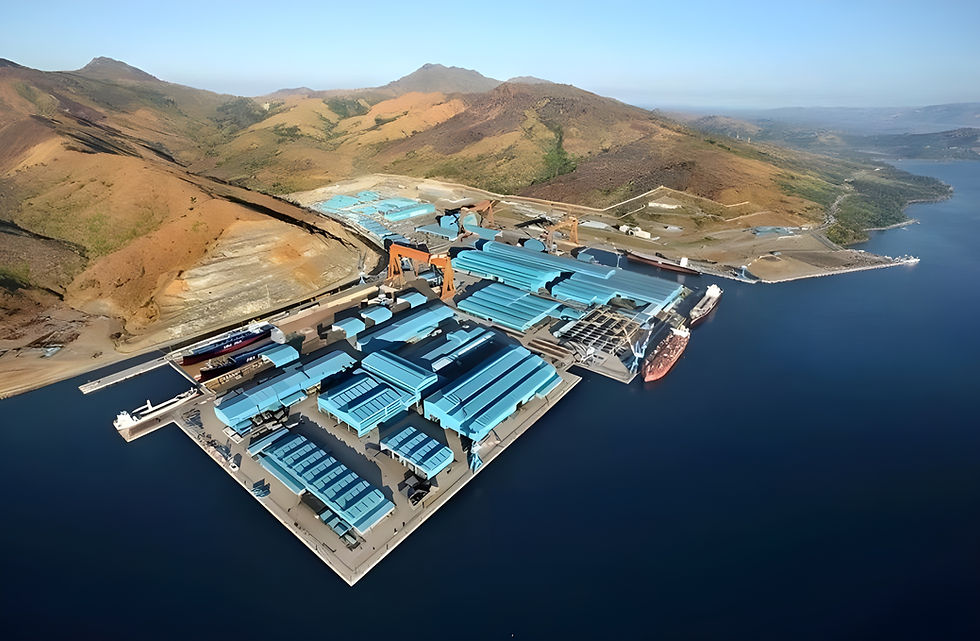U.S. Investor Cerberus Commits Additional $250 Million to Subic Bay and Other Projects
Aug 11, 2025

EXECUTIVE SUMMARY
Cerberus Capital Management is investing an additional $250 million into the Agila Subic Shipyard in the Philippines, bringing its total commitment to $550 million. The site, once owned by Hanjin and defaulted on $1.3 billion in loans, is being transformed into a logistics and industrial hub. Located in the Subic Bay Freeport, the U.S. investment boosts economic ties, regional security, and U.S. presence amid rising Chinese and Gulf port acquisitions.

Author:
John P. Causey IV
U.S. Investor Cerberus Commits Additional $250 Million to Subic Bay and Other Projects
Cerberus Capital Management, a U.S.-based private equity giant with over $65 billion in assets under management, is injecting an additional $250 million into the Philippines. The investment will be used to modernize the Agila Subic Shipyard and support new logistics, energy, and transport-related projects nationwide. This move significantly enhances U.S. commercial and strategic engagement in the Indo-Pacific amid growing competition from Chinese and Middle Eastern investors.
Subic Bay: A Strategic Gateway with U.S. Naval Roots
Subic Bay, located in Zambales Province on the western coast of Luzon, has long been viewed as a strategic maritime asset. From 1901 to 1992, it hosted the U.S. Naval Base Subic Bay, once the largest American military installation in Asia. During the Cold War and Vietnam War, the base served as a key logistics, repair, and resupply hub for the U.S. Pacific Fleet.
The Philippine Senate voted in 1991 to end the U.S. lease, and the base was officially closed in 1992. The area was subsequently converted into the Subic Bay Freeport Zone, designed to attract foreign direct investment with tax incentives, duty-free privileges, and full foreign ownership rights—an exception to the Philippines’ constitutional restrictions on foreign majority ownership in most strategic sectors.
The Fall of Hanjin and Cerberus’ 2022 Entry
The Agila Subic Shipyard, formerly operated by South Korea’s Hanjin Heavy Industries and Construction, was once a symbol of Philippine industrial ambition. It employed over 30,000 workers at its peak and could build massive container ships and tankers for global clients. However, in 2019, Hanjin defaulted on over $1.3 billion in loans to Philippine and South Korean banks and filed for bankruptcy, leaving a major economic void in the region.
Recognizing the site's infrastructure value—300 hectares of land, 2 dry docks, and deep-water port access—Cerberus acquired the facility in 2022 for $300 million, gaining full ownership through the Freeport Zone’s exemptions.
The New $250 Million Investment: What It Will Fund
The latest capital injection brings Cerberus’ total Subic-related commitment to $550 million. According to sources familiar with the matter, the new funds will support:
(1) Modernization of Port and Shipyard Infrastructure
Approximately 40% of the investment, or $100 million, is earmarked for upgrading the shipyard’s two dry docks, deep-water port facilities, and related infrastructure. This includes modernizing berths to handle vessels up to 300,000 deadweight tons (DWT), enhancing crane systems to support a capacity of 1,200 tons, and implementing advanced environmental management systems for ship waste and ballast water, aligning with International Maritime Organization (IMO) standards. These upgrades are expected to increase the shipyard’s capacity to service 50–60 large vessels annually, up from 20–25 in 2023, boosting Subic’s container traffic from 25,000 twenty-foot equivalent units (TEUs) in 2023 to a projected 50,000 TEUs by 2027.
(2) Development of a Multi-Use Logistics and Industrial Hub
An estimated $80 million (32% of the investment) will fund the creation of a logistics and industrial hub within the Subic Bay Freeport Zone. This includes constructing 150,000 square meters of warehousing and storage facilities to support tenants like HD Hyundai Heavy Industries, SubCom, and V2X, which currently occupy the site. The hub is projected to handle 10% of the Philippines’ $30 billion logistics market by 2028, leveraging Subic’s strategic location 100 nautical miles from the South China Sea. Additionally, Cerberus plans to propose converting the Subic Bay International Airport into a cargo and logistics hub, potentially increasing air cargo capacity from 100,000 metric tons annually to 250,000 metric tons by 2030, creating synergies with maritime operations.
(3) Support for Regional Energy and Transportation Initiatives
Approximately $50 million (20%) will be allocated to energy and transportation projects across the Philippines, with a focus on Central Luzon. This includes investments in renewable energy infrastructure, such as offshore wind platforms in collaboration with HD Hyundai, aligning with the Philippine government’s goal to increase renewable energy’s share to 35% of the national power mix by 2030. Transportation initiatives may include upgrading intermodal connectivity, such as road and rail links to Subic, to reduce logistics costs by 15%, supporting the government’s Build Better More infrastructure program, which targets $160 billion in public-private investments by 2028.
(4) Job Creation and Re-Skilling Programs for Local Workers
The remaining $20 million (8%) will fund workforce development, targeting the creation of 5,000–15,000 direct and indirect jobs by 2027, a significant increase from the 3,000 jobs projected during the shipyard’s initial restart in 2022. In partnership with Monark Equipment Corporation, a leading heavy machinery distributor, Cerberus will establish training programs to re-skill 2,000 local workers by 2026 in areas such as advanced welding, maritime engineering, and logistics management. These programs aim to reduce unemployment in Zambales Province (currently 5.8% as of 2023) by 1–2 percentage points and align with the Philippine government’s target to create 1 million jobs annually through foreign investment.
Cerberus is working closely with Monark Equipment Corporation, a heavy machinery distributor, and other partners to accelerate site redevelopment. Some analysts suggest the Subic facility could also serve as a base for regional maritime logistics operations, naval refitting, and possibly defense-related contracts in the future.
U.S. Positioning Amidst Rising Foreign Competition
The move comes at a time when Chinese state-owned COSCO Shipping, DP World, and AD Ports Group from the Middle East have rapidly expanded port infrastructure investments across Asia, Africa, and Europe. COSCO, for instance, controls stakes in over 50 terminals worldwide, including in key choke points like Piraeus (Greece) and Port of Colombo (Sri Lanka).
By contrast, American private capital has been largely absent from Southeast Asia’s strategic port sector. Cerberus’ involvement in Subic therefore stands out as a rare instance of U.S. financial engagement in critical Indo-Pacific infrastructure, aligning with broader U.S. strategic priorities under the Indo-Pacific Economic Framework (IPEF).U.S. involvement in the global port sector has eroded significantly. Today, less than 2% of global terminals are under American ownership or control. The U.S. Merchant Marine fleet has shrunk from over 1,000 internationally trading vessels in the 1950s to fewer than 180 today. Once a global leader in shipping logistics through pioneering companies like Sea-Land—the originator of container shipping—the U.S. now lacks any domestic operator among the world’s top 10 terminal companies by volume or network reach. Despite Southeast Asia handling over 30% of global container traffic, American capital has been largely absent from strategic infrastructure investment in the region for decades.
Implications for the Philippine Economy
The revitalization of the Subic Bay shipyard has the potential to become a major economic catalyst for Central Luzon and the broader Philippine economy. As global supply chains realign and nearshoring gains traction amid U.S.-China trade tensions, the Philippines is positioning itself as a competitive alternative for industrial and logistics investment.
In 2023, foreign direct investment (FDI) into the Philippines totaled $9.2 billion, lagging behind regional peers like Vietnam and Malaysia. Infrastructure bottlenecks and regulatory constraints have long been cited as deterrents, but projects like the Subic redevelopment signal a shift toward higher-value, internationally aligned investment.
Subic Bay Freeport handled just over 25,000 twenty-foot equivalent units (TEUs) of container traffic in 2023—a modest figure compared to major regional ports. However, with renewed capital and strategic partners, volume is expected to grow significantly in the coming years, enhancing Subic’s role as a logistics and industrial hub.
At the macro level, the Philippine economy grew 5.6% in 2023, with infrastructure and manufacturing expansion identified as core pillars of the government’s Build Better More initiative. Cerberus’ investment directly supports these national goals by injecting capital, creating jobs, and attracting secondary industries to the region.
More broadly, this marks a rare case of U.S. private sector reengagement in Philippine strategic infrastructure. Located just 100 nautical miles from the contested South China Sea, the Subic facility offers deep-water access, geopolitical relevance, and a legacy of U.S. naval operations. Because it sits within the Subic Bay Freeport Zone, Cerberus benefits from 100% foreign ownership rights, avoiding typical constitutional limitations.
The investment also aligns with broader U.S. regional strategy, reinforcing economic and security cooperation under the Indo-Pacific Economic Framework (IPEF), the Enhanced Defense Cooperation Agreement (EDCA), and the QUAD. In this sense, Cerberus’ involvement is not just a commercial bet—it’s a strategic signal. It reinforces the evolving U.S.-Philippines alliance while helping to reposition the Philippines as a serious contender in the next era of Indo-Pacific trade and logistics.
VANTAGE'S TAKE
Cerberus’ $250 million investment highlights the Philippines’ potential as a prime entry point for U.S. capital into ASEAN. English is widely spoken, business practices align with U.S. norms, and special economic zones like Subic allow 100% foreign ownership, making the country, in these ways, more accessible than other regional peers such as Vietnam and Thailand. Subic Bay’s location near the South China Sea, ongoing infrastructure upgrades, and alignment with U.S. strategic priorities position it to emerge as both a major regional logistics hub and a strategic base for operations across Southeast Asia.








